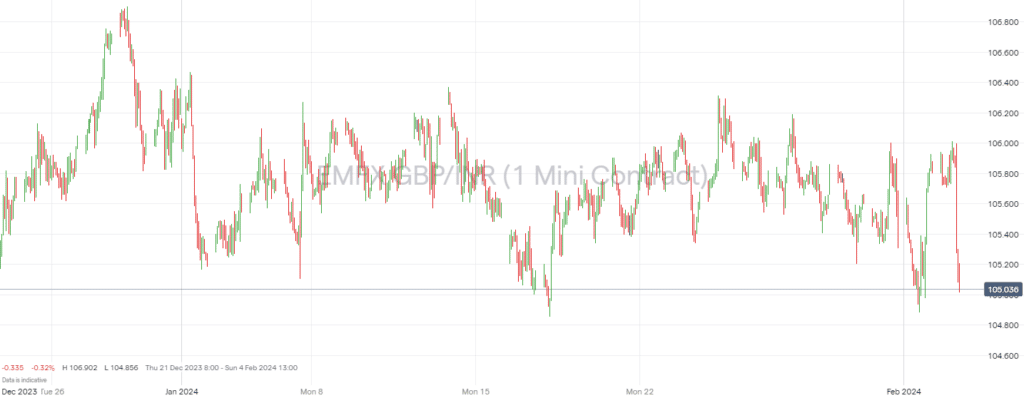The GBPINR (British Pound to Indian Rupee) exchange rate has seen notable fluctuations and trends in recent weeks. The context here is strategic movements against the backdrop of global economic shifts. As of late, the GBP to INR exchange rate tested one-month highs around the 103.6849 mark. This is evidence of Sterling’s resilience against major currencies including the Euro and US Dollar. This movement is reflective of broader economic indicators and policy expectations impacting currency values.
GBPINR Technical Analysis
Foreign exchange analysts from ICICI Securities have shown key technical levels for GBP/INR. They highlighted the currency pair’s sensitivity to global economic dynamics, including inflation forecasts and rate hike expectations. The anticipation of policy adjustments by central banks plays a significant role in shaping the exchange rate. The forecast of higher inflation in Britain, as indicated by the OECD, has stirred speculations of more aggressive rate hikes, potentially bolstering the pound’s position against the rupee.
Looking forward, GBPINR is expected to be influenced by both domestic and international economic factors. Forecast data suggest a gradual shift in the exchange rate, with potential highs and lows marking the currency pair’s trajectory through to 2025. For instance, the forecast for February 2024 suggests a slight increase to 105.87 from an opening rate of 105.37, indicating moderate strength in the Pound against the Rupee. Such trends continue with varying degrees of change projected across coming months, reflecting the ongoing impact of economic policies, market sentiment, and financial forecasts.
This dynamic between the GBP and INR shows the complicated relationship between macroeconomic policies, inflation rates, and central bank decisions on currency valuations. As these factors evolve, the GBPINR exchange rate will likely continue to reflect the broader economic landscape, offering insights into the financial health and policy direction of both the UK and India.

Source: IG Markets
Central Bank Policies Affecting GBPINR
In early 2024, the policy stances of the Bank of England (BoE) and the Reserve Bank of India (RBI) reflect their respective economic conditions and inflation outlooks. This underlines a nuanced approach to navigating their economies through the post-pandemic recovery and geopolitical uncertainties. The GBPINR price shows this this in it’s market dynamics.
Bank of England’s Policy Stance
The Bank of England kept its interest rate at 5.25% for the fourth meeting in a row. Despite holding rates steady, the BoE hinted at the possibility of future rate cuts. However it pushed back against expectations of imminent or significant reductions. This careful stance suggests the BoE’s optimism that inflation will reduce faster and further than currently expected, potentially allowing for a rate cut by June 2024, with a forecast for rates to end 2025 at around 3.00%, below market expectations of 3.25-3.50%.
Reserve Bank of India’s Policy Direction
Conversely, the Reserve Bank of India showed its intention to keep its key interest rate steady at 6.50% until at least July 2024. This shows a more conservative stance compared to some developed market central banks. The RBI’s decision follows a 250 basis point increase in the repo rate. The focus here is on keeping inflation within the 2%-6% target range. Despite a recent drop in core inflation, RBI Governor Shaktikanta Das stressed the need for an actively disinflationary policy until inflation is sustainably close to the 4% target. This conservative outlook is driven by the risks of inflation breaching the 6% upper limit and the need to closely monitor commodity and food costs.
GBPINR – Economic Outlooks
The key difference in policy shows the central banks’ assessment of their domestic economic conditions and inflation outlooks. Readiness by the BoE to consider future rate cuts is predicated on an expected faster reduction in inflation. The RBI’s stance is more guarded, aiming to ensure inflation stabilizes near its target before easing monetary policy. The RBI’s approach also shows its vigilance against potential inflationary pressures. This is despite India’s robust economic growth and its status as the fastest-growing major economy.
The BoE and RBI navigate post-pandemic economic landscapes, which is shown in the GBPINR price. Their monetary policies diverge in timing and emphasis, reflecting their different economic challenges and inflation dynamics. The BoE appears poised for a more accommodating stance in the medium term. Conversely the RBI prioritizes inflation control, hinting at a longer period of policy caution.
Related Articles
